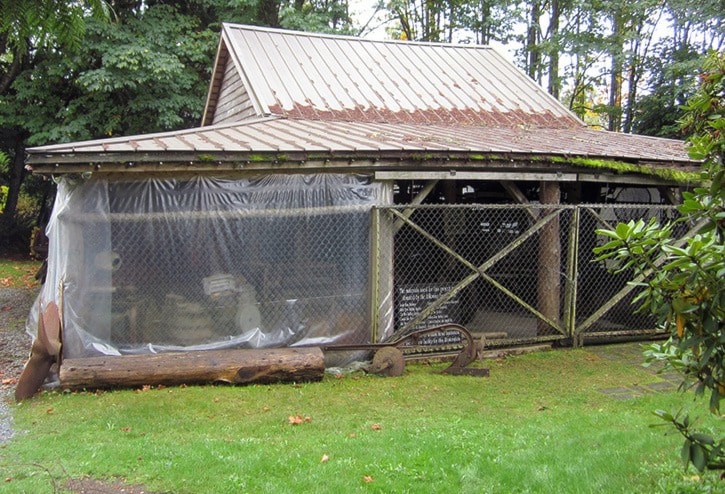By Brianna Shambrook
The Sooke Region Museum has 10 functional buildings on its grounds. One of these buildings is called the Pavilion, and it is where a vast majority of the industrial artifacts are stored.
A lot of museums choose to store industrial artifacts, such as vehicles and farming equipment, outside because they are too big and heavy to bring indoors.
Artifacts that have an outdoor home need regular maintenance and repairs as environmental conditions cause corrosion of the exposed metals. So, the museum created a shelter to minimize the weathering and deterioration of the artifacts.
The Pavilion, built in the late 1970s, has a roof, which was repaired in 2012, and chain link fence siding. It has two floors, but only the lower level is utilized for storing artifacts. Also in 2012, all four sides were wrapped in an industrial strength plastic to minimize the amount of debris that was getting blown into the Pavilion through the fencing. This has proven to be extremely effective and has decreased damage from the elements to the artifacts.
Over the past three summers more than 10 collections assistants have spent time reorganizing and documenting all the artifacts in the Pavilion. One of the biggest challenges we have had is matching each artifact with its identification number because, due to weathering, the numbers have worn off each piece.
There are close to 500 artifacts housed inside the Pavilion. Most of the artifacts are inorganic, meaning they are made from non-living materials such as metal, stone or glass. However, there are artifacts with wooden components inside the Pavilion too. There is a huge range of artifacts from saws, farming equipment, fishing gear, hand operated washing machines, a carriage and even a truck.
The truck (1975.007.001a-c) was donated to the museum in 1975 by Elmer Stolth. The truck, which was made in Canada, is a green 1925-1926 Model-T flat deck Ford. Most of the original structure has been replaced and extensive maintenance has taken place over the last three decades. The truck is situated in the middle of the Pavilion so that it is one of the last artifacts affected by incoming debris and weather conditions.
Another large artifact in the Pavilion is a Massey Harris hay binder (1978.122.001a-m). The binder was donated in 1978 by Alan Goyette and is nearly five feet tall and close to 13 feet long. This binder was built in the first decade of the 1900s. There are remnants of paint suggesting it was once painted red and green. This binder was most likely pulled by horses.
The Pavilion is open, by request, during the summer months. Tours of the Pavilion are also given during school programming in the spring.
•••
Brianna Shambrook is collections and exhibits manager at Sooke Region Museum.
